 W
WAn audio tape recorder, tape deck, or tape machine is a sound recording and reproduction device that records and plays back sounds usually using magnetic tape for storage. In its present-day form, it records a fluctuating signal by moving the tape across a tape head that polarizes the magnetic domains in the tape in proportion to the audio signal. Tape-recording devices include the reel-to-reel tape deck and the cassette deck, which uses a cassette for storage.
The 8-track tape is a magnetic-tape sound recording technology that was popular in the United States from the mid-1960s to the early 1980s, when the Compact Cassette tape, which predated 8-track, surpassed it in popularity for pre-recorded music. The format is obsolete and was relatively unknown outside the United States, the United Kingdom, Canada, New Zealand, Australia, Germany, Italy, and Japan. The main advantage of the 8-Track tape cartridge is that it does not have to be "flipped over" to play the alternative set of tracks.
 W
WThe Ampex 601 was a portable, analog, reel-to-reel tape recorder produced by The Ampex Corporation from the mid-1950s through the 1960s. Ampex manufactured a single-channel model and dual-channel version. The suitcase-sized, 26 lb. unit was designed for the professional recording applications. It recorded to ¼-inch tape on 5-inch or 7-inch reels.
 W
WThe Ampex ATR-100 is a multitrack tape recorder, designed by Ampex Corporation, of Redwood City, California, United States. It was introduced at the Spring 1976 AES Conference in Los Angeles, and was geared towards the ultra high end studio market. The original versions were designed specifically as a stereo or quadraphonic mixdown and mastering deck. It has gained a reputation in the recording industry as the most accurate analogue tape recorder ever to be produced.
 W
WBritish Tape Recorders or BTR machines were reel-to-reel tape recorders initially made by EMI in England after World War II. They were the first magnetic tape recorders to be manufactured in Britain, and their design imitated that of the tape recorders used by the Germans during the war. Because these multi-track recorders were painted EMI green, they then became known as the "Green Machines".
 W
WThe Compact Cassette or Musicassette (MC), also commonly called the tape cassette, cassette tape, audio cassette, or simply tape or cassette, is an analog magnetic tape recording format for audio recording and playback. It was developed by Philips in Hasselt, Belgium, and introduced in September 1963. Compact Cassettes come in two forms, either already containing content as a prerecorded cassette (Musicassette), or as a fully recordable "blank" cassette. Both forms are reversible by the user.
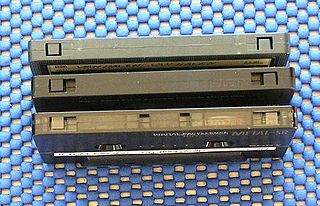 W
WAudio compact cassettes use magnetic tape of three major types which differ in fundamental magnetic properties, the level of bias applied during recording, and the optimal time constant of replay equalization. Specifications of each type were set in 1979 by the International Electrotechnical Commission (IEC). By this time, Type I included pure gamma ferric oxide formulations, Type II included ferricobalt and chromium dioxide formulations, and Type IV included metal particle tapes - the best performing, but also the most expensive. In the 1980s the lines between three types blurred. Panasonic developed evaporated metal tapes that could be made to match any of the three IEC types. Metal particle tapes migrated to Type II and Type I, ferricobalt formulations migrated to Type I. By the end of the decade performance of the best Type I ferricobalt tapes (superferrics) approached that of Type IV tapes; performance of entry-level Type I tapes gradually improved until the very end of compact cassette production.
 W
WDC-International is a tape cassette format developed by Grundig and marketed in 1965. DC is the abbreviation of "Double Cassette", as the cassette contained two reels; International was intended to indicate that, from the beginning, several companies around the world supported the format with suitable tape cassette tape recorders, recorded music cassettes and blank cassettes. Since DC-International did not compete effectively against the similar Compact Cassette, it was discontinued in 1967.
 W
WDigital Audio Tape is a signal recording and playback medium developed by Sony and introduced in 1987. In appearance it is similar to a Compact Cassette, using 3.81 mm / 0.15" magnetic tape enclosed in a protective shell, but is roughly half the size at 73 mm × 54 mm × 10.5 mm. The recording is digital rather than analog. DAT can record at sampling rates equal to, as well as higher and lower than a CD at 16 bits quantization. If a comparable digital source is copied without returning to the analogue domain, then the DAT will produce an exact clone, unlike other digital media such as Digital Compact Cassette or non-Hi-MD MiniDisc, both of which use a lossy data reduction system.
 W
WElcaset is a short-lived audio format jointly developed by Panasonic, Sony, and Teac in 1976, building on an idea introduced 20 years earlier in the RCA tape cartridge.
 W
WThe Fidelipac, commonly known as a "NAB cartridge" or simply "cart", is a magnetic tape sound recording format, used for radio broadcasting for playback of material over the air such as radio commercials, jingles, station identifications, and music. Fidelipac is the official name of this industry standard audio tape cartridge. It was developed in 1954 by inventor George Eash, and commercially introduced in 1959 by Collins Radio at the 1959 NAB Convention. The cartridge was often used at radio stations until the late 1990s, when such formats as MiniDisc and computerized broadcast automation predominated.
 W
WHelical scan is a method of recording high-frequency signals on magnetic tape. It is used in open-reel video tape recorders, video cassette recorders, digital audio tape recorders, and some computer tape drives.
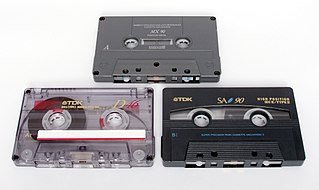 W
WPreservation of magnetic audiotape comprises techniques for handling, cleaning and storage of magnetic audiotapes in an archival repository. Multiple types of magnetic media exist but are mainly in the form of open reels or enclosed cassettes. Although digitization of materials on fragile magnetic media in library and information science is a common practice, there remains a need for conserving the actual physical magnetic tape and playback equipment as artifacts.
 W
WMagnetic tape is a medium for magnetic recording, made of a thin, magnetizable coating on a long, narrow strip of plastic film. It was developed in Germany in 1928, based on magnetic wire recording. Devices that record and playback audio and video using magnetic tape are tape recorders and video tape recorders respectively. A device that stores computer data on magnetic tape is known as a tape drive.
 W
WAn audio tape recorder, tape deck, or tape machine is a sound recording and reproduction device that records and plays back sounds usually using magnetic tape for storage. In its present-day form, it records a fluctuating signal by moving the tape across a tape head that polarizes the magnetic domains in the tape in proportion to the audio signal. Tape-recording devices include the reel-to-reel tape deck and the cassette deck, which uses a cassette for storage.
 W
WMagnetophon was the brand or model name of the pioneering reel-to-reel tape recorder developed by engineers of the German electronics company AEG in the 1930s, based on the magnetic tape invention by Fritz Pfleumer. AEG created the world's first practical tape recorder, the K1, first demonstrated in Germany in 1935 at the Berlin Radio Show.
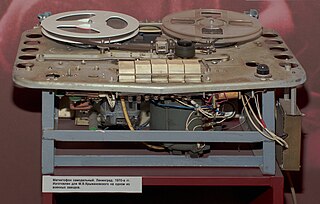 W
WMagnitizdat was the process of re-copying and self-distributing live audio tape recordings in the Soviet Union that were not available commercially. It is similar to bootleg recordings, except it was often sanctioned by the performers for the purpose of circumventing Soviet political censorship and making their work as well known as possible.
 W
WThe Microcassette is an audio storage medium, introduced by Olympus in 1969. It uses the same width of magnetic tape as the Compact Cassette but in a much smaller container. By using thinner tape and half or a quarter the tape speed, microcassettes can offer comparable recording time to the compact cassette. The original standard microcassette, the MC60, gives 30 minutes recording per side at its standard speed of 2.4 cm/s, and double that duration at 1.2 cm/s; an MC90, giving 45 minutes per side @ 2.4 cm/s, is also available from a few manufacturers. Unlike the Compact Cassette, a choice of recording speeds was provided on the original recorders and many others; the tape also spools in the opposite direction, from right to left. For transcription purposes, continuously variable speed was provided on many players.
 W
WThe Mini-Cassette, often written minicassette, is a magnetic tape audio cassette format introduced by Philips in 1967. It is used primarily in dictation machines and was also employed as a data storage for the Philips P2000 home computer. Unlike the Compact Cassette, also designed by Philips, and the later Microcassette, introduced by Olympus, the Mini-Cassette does not use a capstan drive system; instead, the tape is propelled past the tape head by the reels. This is mechanically simple and allows the cassette to be made smaller and easier to use, but produces a system unsuited to any task other than voice recording, as the tape speed is not constant and prone to wow and flutter. However, the lack of a capstan and a pinch roller drive means that the tape is well-suited to being repeatedly shuttled forward and backward short distances as compared to microcassettes, leading to the Mini-Cassette's use in the first generations of telephone answering machines, and continuing use in the niche markets of dictation and transcription, where fidelity is not critical, but robustness of storage is, and where analog media remained in use long after digital media had been introduced.
 W
WMultitrack recording (MTR), also known as multitracking or tracking, is a method of sound recording developed in 1955 that allows for the separate recording of multiple sound sources or of sound sources recorded at different times to create a cohesive whole. Multitracking became possible in the mid-1950s when the idea of simultaneously recording different audio channels to separate discrete "tracks" on the same reel-to-reel tape was developed. A "track" was simply a different channel recorded to its own discrete area on the tape whereby their relative sequence of recorded events would be preserved, and playback would be simultaneous or synchronized.
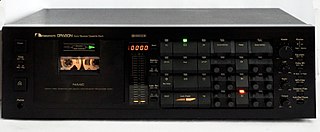 W
WThe Nakamichi Dragon is an audio cassette deck that was introduced by Nakamichi in 1982 and marketed until 1994. The Dragon was the first Nakamichi model with bidirectional replay capability and the world's first production tape recorder with an automatic azimuth correction system; this feature, which was invented by Philips engineers and improved by Niro Nakamichi, continuously adjusts the azimuth of the replay head to minimize apparent head skew and correctly reproduce the treble signal present on the tape. The system allows the correct reproduction of mechanically skewed cassettes and recordings made on misaligned decks. Apart from the Dragon, similar systems have only been used in the Nakamichi TD-1200 car cassette player and the Marantz SD-930 cassette deck.
 W
WPlayTape is a 1⁄8 inch (3.2 mm) audiotape format and mono or stereo playback system introduced in 1966 by Frank Stanton. It is a two-track system, and was launched to compete with existing 4-track cartridge technology. The cartridges play anywhere from eight to 24 minutes, and are continuous. Because of its portability, PlayTape was an almost instant success, and over 3,000 artists had published in this format by 1968. White cases usually meant about eight songs were on the tape.
 W
WPocket Rockers was a brand of personal stereo produced by Fisher-Price in the late 1980s, aimed at elementary school-age children. It played a proprietary variety of miniature cassette which was released only by Fisher-Price themselves. Each tape had two songs in mono. Tapes were available from several pop stars, including Michael Jackson, Whitney Houston, Tiffany, or Debbie Gibson and even rock stars like Bon Jovi or The Bangles. They were designed to be as much of a fashion accessory as a music player, and for a brief period they were enough of a youth craze to be banned in some schools.
 W
WThe TASCAM Portastudio was the world's first four-track recorder based on a standard compact audio cassette tape. The term portastudio is exclusive to TASCAM, though it is generally used to describe all self-contained cassette-based multitrack recorders dedicated to music production. The Portastudio, and particularly its first iteration, the Teac 144, is credited with launching the home-recording wave, which allowed musicians to cheaply record and produce music at home, and is cited as one of the most significant innovations in music production technology.
 W
WThe RCA tape cartridge is a magnetic tape audio format that was designed to offer stereo quarter-inch reel-to-reel tape recording quality in a convenient format for the consumer market. It was introduced in 1958, following four years of development. This timing coincided with the launch of the stereophonic phonograph record. It was introduced to the market by RCA in 1958.
 W
WReel-to-reel audio tape recording, also called open-reel recording, is the form of magnetic tape audio recording in which the recording medium is held on a reel that is not permanently mounted in an enclosed cassette. In use, the supply reel containing the tape is placed on a spindle or hub; the end of the tape is manually pulled out of the reel, threaded through mechanical guides and a tape head assembly, and attached by friction to the hub of the second, initially empty takeup reel.
 W
WThe Revox B215 is a cassette deck manufactured by Studer from 1985 until around 1990. A professional version with different control layout and audio path electronics was manufactured concurrently as the Studer A721. A later improved version was marketed as the Revox B215S. Because it was expensive compared to other consumer models and had exceptionally good mechanical performance and durability, the B215 was used primarily by professional customers—radio stations, recording studios and real-time cassette duplicators.
 W
WSabamobil was a magnetic tape audio cartridge format made by SABA that came to the market in 1964. It used already-available four-track ¼ inch tape on 3-inch reels (7.62 cm), with two mono channels per side, using a tape speed of 3¾ ips (9.5 cm/s), and was compatible with reel-to-reel audio tape recording except the against remove secured ends of the tape in the reel. The cartridge could be opened without the need of any tools by removing two holding clamps. Tape head and capstan were placed between the reels.
 W
WThe Sanyo Micro Pack 35 was a portable magnetic audio tape recording device, developed by Sanyo in 1964, that employed a special tape cartridge format with tape reels atop each other.
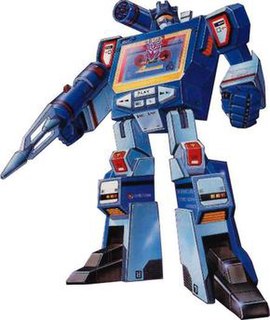 W
WSoundwave is a fictional character appearing in the various Transformers continuities in the Transformers robot superhero franchise. His most well-known transformation is that of a microcassette recorder. Throughout most of his incarnations, he is an undyingly loyal lieutenant of the Decepticon leader Megatron. He is commonly depicted as Megatron's communications officer and, in some interpretations, only speaks when mocking the Autobots.
 W
WThe Steno-Cassette is an analog cassette format for dictation, introduced by Grundig in 1971. It gained widespread use in Germany, where it was established as a DIN standard in 1985. It is easily distinguished from other dictation cassette formats by the integrated tape counter index, showing the amount of tape available.
 W
WThe Muntz Stereo-Pak, commonly known as the 4-track cartridge, is a magnetic tape sound recording cartridge technology. The in-car tape player that played the Stereo-Pak cartridges was called the Autostereo, but it was generally marketed under the common Stereo-Pak trade name.
 W
WSticky-shed syndrome is a condition created by the deterioration of the binders in a magnetic tape, which hold the ferric oxide magnetizable coating to its plastic carrier, or which hold the thinner back-coating on the outside of the tape. This deterioration renders the tape unusable. Some kinds of binder are known to break down over time, due to the absorption of moisture (hydrolysis).
 W
WTape bias is the term for two techniques, AC bias and DC bias, that improve the fidelity of analogue tape recorders. DC bias is the addition of direct current to the audio signal that is being recorded. AC bias is the addition of an inaudible high-frequency signal to the audio signal. Most contemporary tape recorders use AC bias.
 W
WA tape head is a type of transducer used in tape recorders to convert electrical signals to magnetic fluctuations and vice versa. They can also be used to read credit/debit/gift cards because the strip of magnetic tape on the back of a credit card stores data the same way that other magnetic tapes do. Cassettes, reel-to-reel tapes, 8-tracks, VHS tapes, and even floppy disks and modern hard drive disks all use the same principle of physics to store and read back information. The medium is magnetized in a pattern. It then moves at a constant speed over an electromagnet. Since the moving tape is carrying a changing magnetic field with it, it induces a varying voltage across the head. That voltage can then be amplified and connected to speakers in the case of audio, or measured and sorted into ones and zeroes in the case of digital data.
 W
WA tape transport is the collection of parts of a magnetic tape player or recorder that move the tape and play or record it. Transport parts include the head, capstan, pinch roller, tape pins, and tape guide. The tape transport as a whole is called the transport mechanism.
 W
WWire recording or magnetic wire recording was the first magnetic recording technology, an analog type of audio storage in which a magnetic recording is made on a thin 37 gauge (0.004") steel wire. The first crude magnetic recorder was invented in 1898 by Valdemar Poulsen. The first magnetic recorder to be made commercially available anywhere was the Telegraphone, manufactured by the American Telegraphone Company, Springfield, Massachusetts.